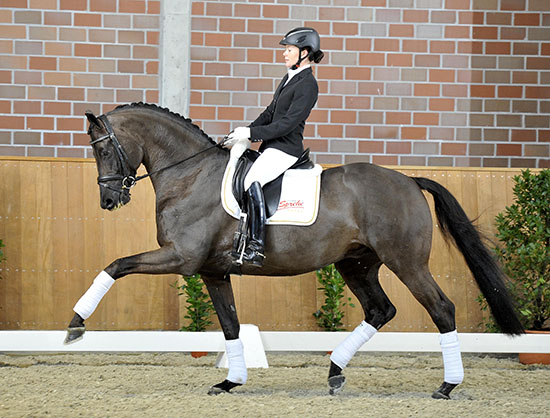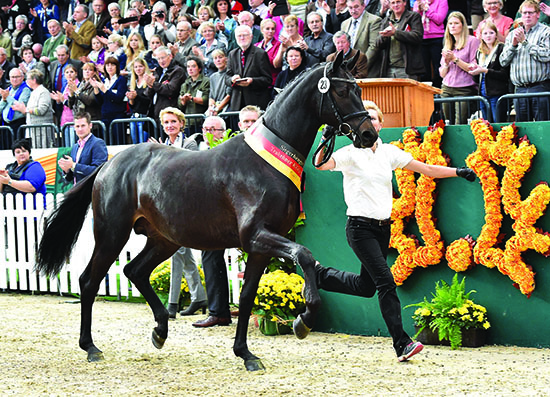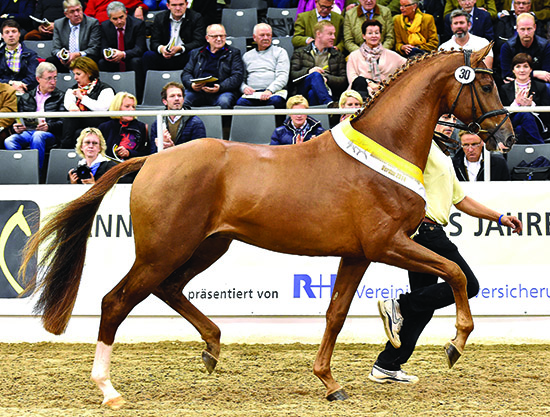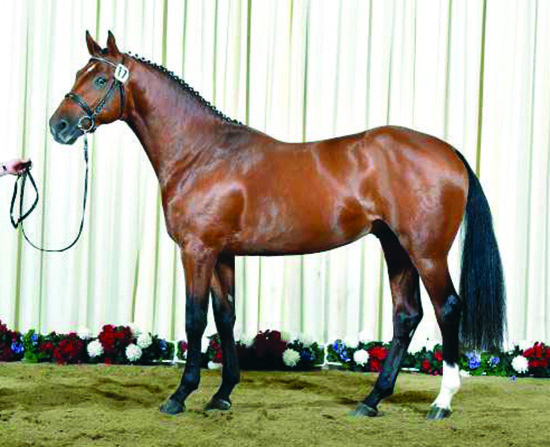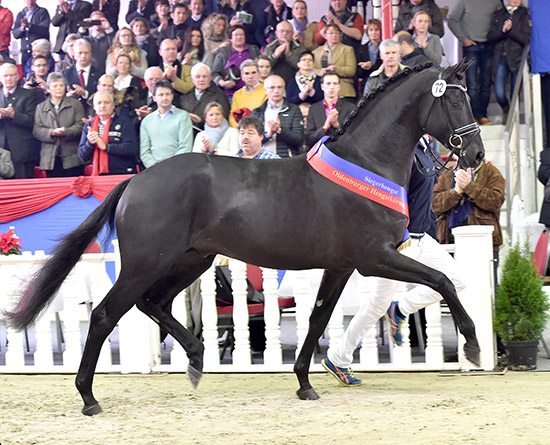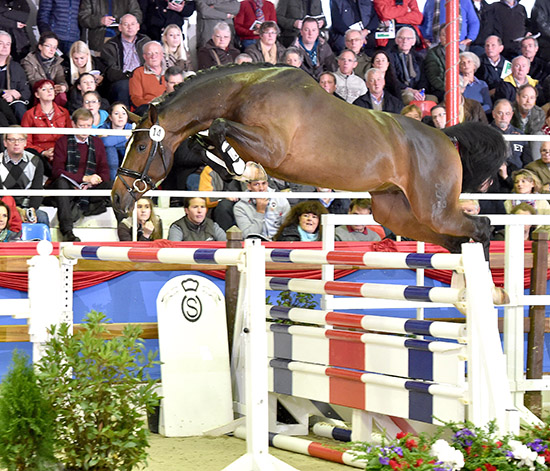Above – Flavour of the year, Millennium with Kristina Sprehe
The coming of the Millennium…
Christopher Hector looks at the new crop of champion young stallions….
Photos by Kiki Beelitz
Throughout Europe, breed administrators are under severe pressure as the numbers of mares covered continues to drop and the Warmblood breeding industry economic downturn continues. Perhaps this pressure may have contributed to some of the slightly ‘left field’ licensing decisions, as the various commissions try desperately to discover the stallion that will re-ignite the mare owners passion to breed…
The Trakheners have always seemed to march to the beat of a somewhat different drummer, but this time their re-vamped stallion licensing set the trend for the rest of Germany when they crowned, Sir Sansibar, their champion – one of five sons of the Sprehe-based stallion, Millennium, that they licensed. Sir Sansibar was sold for €300,000 to Austria’s Eva-Maria Aufrecht, which given the prices for Millennium colts at all the subsequent licensing auctions, was something of a bargain… although sometimes there is just a tiny suspicion when we see the massive auction prices that there might have been an agreement between the buyer and seller to inflate the numbers as a handy marking tool.
Sir Sansibar sets the trend…
Two other sons of Millennium were approved, Ivanhoe, out of Iteresse II (by Hohenstein and a full sister to Carola Koppelmann’s Grand Prix ride, Insterburg TSF), who sold for €52,000 and Octavian, out of Ode II, also by Hohenstein, he went for €100,000.
The action shifted to Hanover, where some of the heat has gone out of the licensing following the decision a couple of years ago not to declare a licensing champion to try and stop mare owners blindly flocking to whoever that colt happened to be. There is however,the high selling colt, which is much the same thing, and in this case, the top seller at €620,000 to a Danish dressage stable, was a chestnut, by Don Juan de Hus out of a Londonderry mare, Linda. This is very much the Dutch / German fusion. Don Juan de Hus is essence of Dutch dressage – by Jazz out of a Krack C mare, while the dam, is out of a Walt Disney (by World Cup) mare. The full-sister to Linda, Let’s Dance LH is winning at S level at the age of eight.
By Don Juan de Hus out of a Londonderry mare…
The rest of the dressage colts were relatively traditionally Hanoverian. The revival of the ‘B’ line continues, with three grandsons of Brentano II (two by Bennetton Dream, one by Belstaff) with a newcomer, Don Index, putting two into the top group. Don Index won his Performance Test in 2010, and once again demonstrates the extraordinary ability of the Donnerhall line to produce stallion sons of stallion sons. Don Index is by Don Crusador, by Don Bosco, by Donnerhall. On the dam side, he is by Wolkentanz and descends from one of Hannover’s oldest mare families, that of Jahde, the family that produced Sven Rothenberger’s Grand Prix ride, Weyden. There was some more Dutch influence, with one premium colt by Totilas (dam by Sandro Hit) and another by Vivaldi, again out of a Sandro Hit mare.
A customer from the Ukraine paid €160,000 high selling jumping colt – by Los Angeles, out of I Kola-U, who is a wonderful blend of jumping blood. I Kola-U is by the Narcos II son, It’s Me de Mesnil, out of a mare of Almé / Pilot breeding. Los Angeles is by the Lordanos son Light On, out of an Argentinus / Bariton mare. Los Angeles was the Westfalien licensing champion in 2010, and died in 2013. The sires of the other premium jumping colts were: Arpeggio, Goldfever, Graf Top, Quite Rubin and Stolzenberg.
The controversy continued in normally staid and conservative Holstein where for the first time ever there was a ring of dressage specific colts up for evaluation. Okay all breed administrators like to claim that their output constitutes the breed for every need, and there has been the odd fluke like Corlandus, but the traditional strength of the Holstein breed has been a single-minded concentration on jumping horses.
Even the jumping ring was not without its share of controversy, with suggestions that the commissioners were ‘Trakehnerizing’ the breed, selecting pretty and modern, and neglecting the time-honored virtues of scope and carefulness.
Caracho, champion in Holstein…
There was criticism of the licensing champion, Caracho, on the grounds of his size (1.64) but mainly because of his sire, Cassilano, whose best claim to fame is that he was himself a licensing champion. Cassilano went on to do a so so performance test, placing 8th out of 48 candidates, and in the 2012 season won several Young horse jumping classes, and at the Bundeschampionat qualified for the final. And then? When I check that splendid data base, The Showjumping Archive (www.sja.it) there’s nothing, not one single international placing, not even in a young horse class…
It’s Millennium again, this time out of a Rubin Royal / De Niro / Rubinstein mare…
The next to get on the Millennium band-wagon was Oldenburg, where their licensing champion was a very attractive black colt, by Millennium out of a Rubin Royal / De Niro / Rubinstein mare. Who is this sire? This stallion that comes along every one in a thousand years? Millennium was the Reserve Champion of the 2010 Trakehner licensing, thence, second in the dressage at his 30 day test and first of the dressage scores in a 70 day test in 2013. In 2012, he ‘won several young horse riding classes’ – and in 2014?? His sire, Easy Game is by Gribaldi out of a Schradroneur mare, both these stallions competed Grand Prix, but Easy Game we are told is ‘educated to S level in Holland’ although thus far he has not troubled the folks who maintain the FEI database record of all international performances from Prix St Georges up.
The Millennium son sold for €755,000 to Gestüt Bonhomme after a bidding war that involved Paul Schockemöhle who seems to have developed a taste for black stallions of Trakehner breeding. There was some consolation for Paul in that he bred, and retained the ownership, of the Reserve champion – by Totilas out of a Don Frederico / Sandro Hit / Esprit mare.
I asked my pal the Trakehner expert about this new Trakehener superstar, and while he must go nameless since he has a wife and family to support, my informant is not only very well informed, but a genuine fan of the Trakehener breed.
He pointed out that the year Millennium was third at his licensing, was the year Paul Schockemöhle bought Totilas, and that it was a year in which black Trakehners with the name Gribaldi in their pedigree, were keenly sought after. Millenium apparently did not enjoy the best reputation because of his sire, Easy Game, who seemingly was not easy at all, and who, whenever he appeared in public, was only led by that stallion master, Joep van Uytert, and then always on a lungeing rein, since the stallion not only had the tendency to stand on his hind legs, but also tried to kick his handler! However my friend is fulsome in his praise of Easy Game’s dam, the Schwadroneur mare, Evita, a former auction top seller. Nowadays it would seem that Easy Game is a reformed character. Half share in Easy Game has been purchased by the Belgian based Dutch rider Veronique Swagemakers and her partners and Ms Swagemakers intends campaigning the stallion at Grand Prix level… time will tell.
Millenium is described as ‘not too calm, but by far not as awful as his sire, just a little cheeky, a young stallion, and he was by far the most beautiful of all the stallions at the licensing.’
Millenium was purchased by Sprehe together with Moritzburg State Stud, and right from the start he was impressive under saddle, ridden by Kay Pawlowska from Moritzburg. At the Trakehner championships, they were second in the final. Since then the ride has been taken over by Kristina Sprehe and the word is that they are getting along quite well, although there is a rumour that the stallion might be taken out of breeding to make him easier to ride (although, if this is the case, why would Sprehe have sold his son, the licensing champion at Oldenburg?)
The Trakehner licensing champion, Sir Sansibar, my informant describes as ‘typically showing the Gribaldi points, calm, not too active from behind but good to work and handle’. And the Oldenburg champion? It seems that he was the horse everyone was talking about and ‘of course, Rubin Royal / De Niro is a nice combination and can almost guarantee active hind legs… he was really an outstanding stallion, not only because of his colour, but because of his attitude. He looked smart, clever, and it would seem that the €755,000 price tag reflected the fact that ALL the big studs were interested in him.’
The verdict: ‘Time will tell if Millennium is the one to improve all breeding programs and if he will become a performer with Kristina Sprehe. From a breeding point of view I think you need an active mare that lacks a bit of that sought after flamboyant front (face, neck, shoulder, front leg). And of course for all Warmblood breeds, it is interesting to have a stallion that has no Sandro Hit or Florestan or Donnerhall blood.’
In the OS (Oldenburg Jumping) section, 34 jumping stallions were presented, 16 received the tick of approval, five were awarded premium.
The OS champ – by Coupe d’Or out of a Stakkato Gold mare…
The title of Champion stallion was awarded to a son of Coupe d’Or, out of a dam by Stakkato Gold. The young stallion followed in the footsteps of his sire, Coupe d’Or who was Champion stallion in 2012. He was bred by Albert Sprehe and presented by his son, the international showjumper Jan Sprehe. Actually the Sprehe brothers bred both the jumping and the dressage champion colts at Vechta, so their breeding operation is going quite well – not to mention producing an international jumping rider in Jan and a German dressage team member, Kristina. Coupe d’Or is by the Calido son, Coupe de Couer out of a mare by the Thoroughbred, Rivero, out of a mare of Lordanus / Grannus breeding.
Silver went to a product of Paul Schockemöhle’s Lewitz Stud, a bay stallion by Action Breaker out of a Contender/Continue/Pilot mare. He is closely related to the dam line of Tante, which has already produced a number of international showjumpers and licensed stallions. A son of Casino Berlin out of dam by Contact Me (Landadel), bred and presented by Gerd Sosath, was awarded with Bronze.
Over in Westfalia, when the stud at Warendorf sent its top stallions to Johann Hinnemann’s stables to be ridden by Marlies van Baalen, the joke used to be, what does NRW stand for? Netherlands riding Westfaliens… now they are not riding them, they are inseminating them! Five of the top colts were Dutch bred including the licensing champion, a bay by Boston out of a Fidermark mare. Boston is by Jazz out of a Flemmingh mare, and while he was not KWPN approved, he stood a couple of seasons in Westfalia before his premature death in 2009 while in training with Isabell Werth. The Boston son sold to Klosterhof Medingen for a whopping €710,000.
By Boston out of a Fidermark mare – the Dutch influence in Westfalia grows…
Another stallion that did not received the KWPN seal of approval, Vitalis provided three of the top ten, including the reserve champion who was out of a Dancier / Worldly / Akatschi mare. This colt was sold at auction for €270,000 to Sissy Max-Theurer.
Vitalis (Vivaldi / D-Day) after standing reserve at the Westfalian licensing, and being failed at the Dutch, was sold to the United States.
Other premium stallions of Dutch extraction were Heinrich Ramsbrock’s Apache / Münchhausen / Fabriano; H.S.S. Pferdesport’s Sorento /Krack C/Cocktail); and Josef Platte’s Vitalis / Levados / Florestan, which sold at auction for €420,000 to Switzerland.
Milliennium was popular in Westfalia as well, with three colts approved for the Westfalien book, one of which made the premium ring, Walter Droege’s Millennium / Furst Heinrich / Weltmeyer / Azur.
As my late mother-in-law would want to say, fancy.


